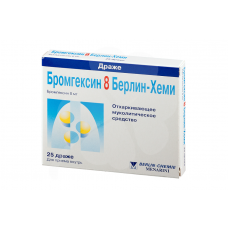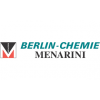Expiration date: 09/2026
Composition and form of issue:
5 ml of the mixture (1 measuring spoon) contains Bromhexine hydrochloride 4 mg in bottles of dark glass of 60 ml in a set with a measuring spoon, in a cardboard pack 1 set.
1 dragee contains 8 mg of Bromhexine hydrochloride in a blister of 25 PCs., in a box of 1 blister.
Pharmacological action:
Causes depolymerization of mucoprotein and mucopolysaccharide polymer molecules (mucolytic effect). It stimulates the production of endogenous surfactant, providing stability of alveolar cells during respiration, their protection from adverse factors. Surfactant helps to improve the rheological properties of bronchopulmonary secret, its "slip" on the epithelium and facilitates the release of sputum from the respiratory tract.
Pharmacokinetics:
Almost completely absorbed. Plasma protein binding — 99%. The volume of distribution — about 7 l/kg. Penetrates the BBB and placental barrier, as well as breast milk. T1/2 — from 1 to 16 no. Excreted only in the urine in the form of metabolites.
Indications:
Acute and chronic diseases bronchus and lung violation othozdenia patients.
Contraindications:
Hypersensitivity.
Use during pregnancy and breast-feeding:
Used with caution only as directed by your doctor.
Side effect:
In rare cases, dyspeptic disorders, allergic reactions.
Drug interaction:
Promotes the penetration of antibiotics (erythromycin, cephalexin, oxytetracycline) into the lung tissue.
Dosage and administration:
Inside, adults and children over 14 years — 8-16 mg 3 times a day for children under 14 years and patients weighing less than 50 kg — 8 mg 3 times a day for children under 6 years — 4 mg 3 times a day.
Precautionary measures:
With caution prescribed for gastric ulcer. It is not allowed to use in combination with antitussives (codeine), since the depressed cough reflex may stagnate secretion in the respiratory tract.



